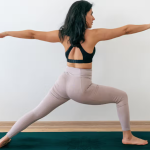All teachers have their own strengths, their own vocabulary and their own ways of creating sequences — and so will students. Lots of people will ‘shop around’ with different yoga classes in the same way we would do when purchasing an expensive item — we want to find a teacher who will help us grow, who seems to understand us, how to best nourish us and whose narrative and teaching cues we most align with.
When Using Teaching Cues
Yoga teachers will often have regulars in their class, from seasoned yogis to those who have been at least practicing for a while — but what about the newbies? Those trying a yoga class for the first time or returning to yoga after many years. These are the students who can be most harmed by the narrative we use in when teaching classes.
Of course all teachers want to help their students feel positive, cope with stress and encourage growth, and to help them understand their bodies and minds more however there are certain cues that actually block ease, limit strength and ultimately prevent freedom within practice.
We have outlined five teaching cues which we feel need to be stripped and left, amongst the clutter of shoes, at the door. That way, you can focus on the teaching cues which encourage development, potential and acceptance in a safe and inclusive way.
See Also: The 5 Basic Principles of Yoga Sequencing
1. Pull your shoulder blades down
Stability is key to preventing injury and mobility is the body’s ability to participate in mindful movement. We need both of these to practice yoga with strength and ease. Yoga actually strengthens both mobility and stability and many poses require shoulder stability in particular to allow for a strong, dynamic practice; downward dog for example, or wheel pose, both need a great amount of shoulder stability.
The cue, “pull your shoulder blades down,“ limits their intricate pattern of movement and can lead to immobility and instability. The shoulder blades need to be able to move toward the ribcage and, in turn, the ribcage toward the shoulder blades thus pulling your shoulder blades down encourages your ribs to natural extend outward rather than toward the shoulders.
What you can say instead
- Move the front of the shoulders back.
- Broaden the collar bones.
- Lift the chest.
- Move the base of the skull back.
See Also: 5 Simple Poses to Strong Shoulders
2. Tuck your tailbone
Some people have extreme curvature of the lumbar spine and scooping the tailbone under seems to be an obvious way in which to get someone to lengthen out their lower back. Although more practiced yogis may find this cue helpful for many it can be awkward and challenging because it seems to suggest that the student pull their tailbone forward and push the pelvis out of neutral and into a posterior tilt.
What you can say instead
- Ground your tailbone downwards.
- Draw your hip points toward each other and engage the pubic bone and the navel.*
*This helps to balance the pelvis
3. Flatten your back
Firstly, it is impossible to really do anything with a ‘flat’ back as three curves exist in a neutral spine. Just as in nature – there is no straight line. Secondly, it is not desirable to try and flatten out our backs as we can start to reverse the natural curves and lower the level of shock absorption, create problems in the lumbar spine and stunt the range of motion. It is really important to understand how the spine can be positioned in poses in order to protect it, particularly in forward folds.
What you can say instead
- Draw your naval toward the spine
- Avoid making a V shape with your back
4. Stack your shoulders over your wrists
We may often look toward the alignment of the knee over ankle or shoulder over wrist to decide whether a student is correctly aligned or not. However, asking people to stack their shoulders over their wrists when getting into side plank can often lead to people allowing their hips to slump.
What you can say instead
- Place your wrist in front of your shoulder.
- Make sure your wrist is slightly more forward than your shoulder.
5. Square your hips to the front of the room
We’ve all heard this a thousand times in a yoga class and sometimes it makes sense however at other times it may pose a problem — particularly in Warrior One — where the back foot is grounded toward the edge of the mat. If you try to pull either hip forward in order to align them forwards, you run the risk of painfully forcing the knee into a twist.
What you can say instead
- Use your belly to bring your torso forward and toward your front leg.
6. Turn your gaze inward
While for well-versed yogis this phrase is totally fine, for newcomers it seems an impossibly frustrating and vague instruction. When starting out with yoga, we are focused on the body: on keeping our balance, on making sure we have the pose correct, on trying to keep our focus on the pose. While for some of us, the instruction to turn our gaze inward is a welcome invitation to fold further in our ‘me’ time – for many it is a ‘typical yogi’ term and can, at times, cause people to feel isolated.
What you can say instead
- Check in with yourself and see how you are feeling
- If it feels comfortable to do so, draw your attention to yourself













